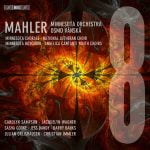
Composer: Jean Sibelius
Orchestra: Minnesota Orchestra
Conductor: Osmo Vänskä
Audio CD
Number of Discs: 1
Format: FLAC (tracks)
Label: Bis
Release: 2016
Size: 1.25 GB
Recovery: +3%
Scan: yes
Symphony No. 3 in C major, Op. 52
01. I. Allegro moderato
02. II. Andantino con moto, quasi allegretto
03. III. Moderato – Allegro (ma non tanto)
Symphony No. 6 in D minor, Op. 104
04. I. Allegro molto moderato
05. II. Allegretto moderato
06. III. Poco vivace
07. IV. Allegro molto
08. Symphony No. 7 in C major, Op. 105
Recorded: May and June 2015
Recording Venue: Orchestra Hall, Minneapolis, USA
The long-awaited final disc in the Sibelius cycle from Minnesota Orchestra and Osmo Vänskä
The first disc in the Sibelius cycle from Osmo Vänskä and Minnesota Orchestra made the reviewer in Gramophone speculate about a ‘benchmark cycle for the 21st century’ whilst the second instalment received a Grammy for ‘Best Orchestral Performance’. The long-awaited final disc in the cycle, with a playing time of 82 minutes, combines the Finnish master’s third symphony, completed in 1907, with his two final works in the genre, composed more or less in tandem between 1922 and 1924. Symphony No. 3 in C major is Sibelius’s most classical symphony, a radical change in direction after the opulence of its predecessor. It has been claimed that the mastery of form in its first movement is comparable only to the greatest Viennese masters – and at the same time the conductor Koussevitzky, one of the composer’s strongest champions, spoke of it as ‘music far in advance of its time’. Fifteen years later, and after the heroic Fifth Symphony, Sibelius again presented a symphony which surprised those admirers who expected more of the same. Sibelius gave Symphony No. 6 a refined modal flavouring, avoiding both virtuoso orchestral writing and massive climaxes, and likened it to an offering of ‘pure spring water’. This he followed up immediately with what would become his symphonic swan song – the stern and majestic Seventh Symphony. A one-movement work, it was at first billed as ‘Fantasia sinfonica’ but it is indeed a true symphony, its single movement portraying elements of all four movements of symphonic practice.



